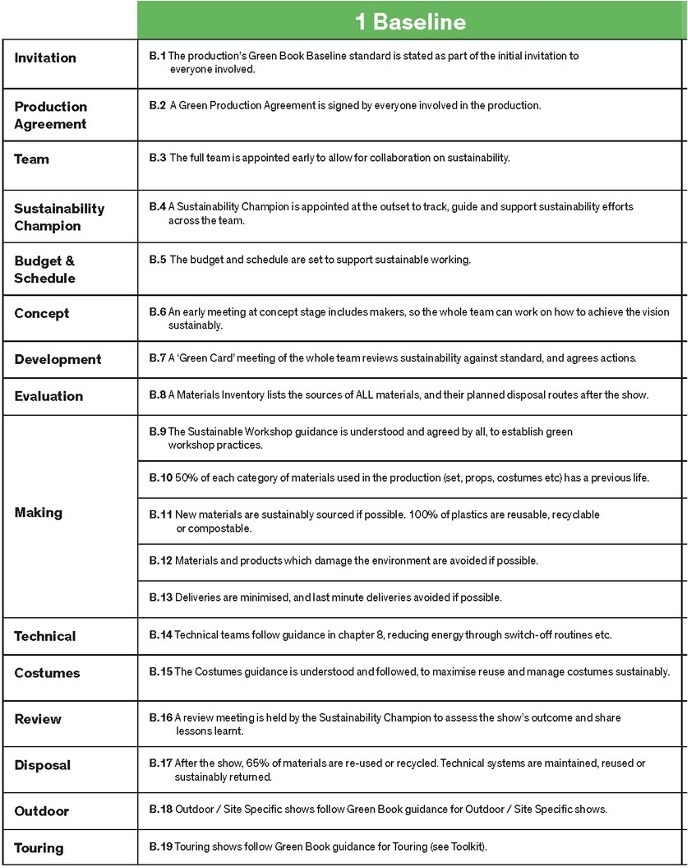This case study focuses on the sustainability outcomes of student production Sweeney Todd: The Demon Barber of Fleet Street, performed at NIDA from 9-17 June 2023. With a cast and crew of over 70 including a live band of seven musicians, it was staged in the Playhouse Theatre. Full production details can be found here.
Sweeney Todd was designed, built, rehearsed, performed and bumped-out over a 10-week period. Students led and documented production activities and processes with support from teaching staff and professional mentors.
When designing and delivering environmentally sustainable productions, NIDA uses the Theatre Green Book (TGB) as a working framework. In 2023, NIDA’s aim was to ensure that one in four productions in the June and October production seasons achieved the Theatre Green Book (TGB) ‘Baseline’ standard. In short, TGB Baseline requires that;
- 50% of materials used in a production have had a previous life,
- 65% of materials are reused or recycled at the end of the production,
- travel, deliveries and use of harmful chemicals are reduced.
Sustainability considerations were introduced to all production teams early in the design collaboration process, with directors encouraged to lead environmental sustainability discussions with students. Production teams were provided with an overview document outlining the TGB Baseline principles and a request that environmental sustainability be embraced as both an individual and team commitment throughout the production process.
NIDA’s Sustainability Manager provided a briefing to directors, designers and third-year students on TGB Baseline principles, and key principles of environmental sustainability and carbon emission literacy. Sustainability goals were included in the company welcome packs and addressed in feasibility discussions and production meetings. A version of the TGB contract was provided for production teams to sign.
Production teams captured the TGB Baseline percentages in The WasteTracker, a waste acknowledgement spreadsheet developed by Chris Milburn, a third-year Technical Theatre and Stage Management (TTSM) NIDA student. The spreadsheet documents the range of materials used in each production across all departments. Students were asked to provide data that identified the source of products and materials, the purchase location and the proposed mode of disposal.
As an additional step, NIDA undertook an external calculation of the production’s carbon footprint to quantify the amount of carbon used in productions. The information contained in The WasteTracker, along with student ground plans and equipment lists, informed the carbon emissions footprint estimates.
Both the TGB and carbon footprint measurement systems document different aspects of a production’s environmental footprint. TGB is a qualitative tool that promotes thinking about where items come from, what they are made of and where they go after a production closes. It actively encourages the reuse and recycling of commonly used items. Carbon emissions calculation is a quantitative tool that measures the embodied carbon of items, based on a variety of measurable factors, including their base material, manufacture, shipping and weight. Emissions factors were sourced from the National Greenhouse Accounts Factors 2023. The calculations of the production will not be used for carbon accreditation in any form.
Theatre Green Book – Baseline
The NIDA student production of Sweeney Todd successfully met the TGB Baseline target: 50% of materials had a previous life and 65% of materials were reused or recycled at the end of the production.
Procurement or sourcing of materials for SweeneyTodd achieved the following outcomes
Reused: 62% | Recycled: 4% | New: 35%
The end-of-life handling of material achieved the following outcomes
Recycled: 11% | Storage: 76% | Waste: 16%
Carbon calculation footprint
Sweeney Todd’s carbon footprint of new items totalled 1997 KgCO2e. If all items were sourced new and no interventions were made, the potential footprint would have been 5965 KgCO2e. The total footprint of stock and reused items was 3968 KgC02e.
As a result, the carbon footprint for Sweeny Todd was reduced by 66%.
| Department | New items(KgC02e) | Stock/re-used items (KgC02e) | Potential Footprint If all items were new(KgC02e) |
|---|---|---|---|
| Workshop | 1310 | 1865 | 3175 |
| Properties | 180 | 819 | 999 |
| Costume | 352 | 1271 | 1623 |
| Lighting | 116 | 10 | 126 |
| Sound | 39 | 3 | 42 |
| Totals | 1997 | 3968 | 5965 |
| Total % | 33% | 66% | 100% |
Notes:
- Production energy: carbon emissions associated with the energy required to power equipment and infrastructure for the production was estimated at 1052 kgC02e.
- Venue infrastructure: embodied carbon emissions associated with the manufacturing of venue equipment and infrastructure to support the production was estimated at 1902 kgC02e.
As NIDA continues to track and monitor student productions over subsequent seasons, the data and insights collected will help to inform NIDA’s policies, training, systems design and budgets.
For more information please contact NIDA’s Sustainability Manager – [email protected]
THEATRE GREEN BOOK BASELINE


